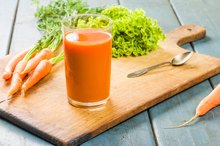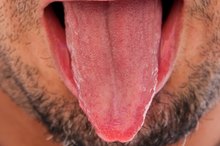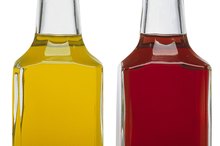Does a Highly Acidic Diet Cause Tongue Pain?
Tongue problems can result from injury, smoking, vitamin deficiency, taking antibiotics, using mouthwash and allergic reactions to certain foods 2. But for some people, acidic foods are to blame. Understanding how high-acid foods might directly or indirectly lead to tongue pain, as well as the kinds of tongue pain that exist, will help you determine dietary changes and treatment options that may ease tongue pain.
Acidic Foods
The definition of an “acidic” food to an oral health professional may differ from that used by advocates of the “acid alkaline diet” that aims to balance the body's pH levels, notes Columbia University’s Health Services program. Acidic foods that might irritate your tongue and erode tooth enamel include pineapple, citrus fruits, apples and grapes, as well as wine and fruit juices made from grapes or apples. Other foods high in this kind of acidity include yogurt and sodas. In terms of pH balance and digestion, lemons and vinegar actually rank low in acidity, while grains, dairy and beans are “high-acid” foods. If you are concerned about tongue pain and acidic foods, specify to your doctor or dentist exactly what foods you consume.
- The definition of an “acidic” food to an oral health professional may differ from that used by advocates of the “acid alkaline diet” that aims to balance the body's pH levels, notes Columbia University’s Health Services program.
- Acidic foods that might irritate your tongue and erode tooth enamel include pineapple, citrus fruits, apples and grapes, as well as wine and fruit juices made from grapes or apples.
Temporary Pain
Tooth Pain and Sweets
Learn More
According to the Merck Manual Home Edition, temporary tongue pain is known simply as “tongue discomfort.” Pineapple and other acidic foods may irritate the tongue, as can injury and fungal disease 1. The handbook suggests eliminating suspected irritants one by one until you determine the likely culprit.
Secondary Symptom
Some people experience tongue pain as a secondary response to tooth and gum pain, MedlinePlus notes 23. In this case, an acidic diet may come into play by breaking down tooth enamel. Eroded tooth enamel can lead to cavities or an abscess, a kind of infection that causes toothache and temperature sensitivity in the mouth, among other symptoms 3. If you have tongue pain as well as mouth or tooth pain, ask your dentist to check for cavities and oral infections.
Burning Mouth Syndrome
Anusitis Diet
Learn More
While some tongue pain comes from a temporary irritation from acidic foods, burning mouth syndrome is a long-term issue. It is more common for acidic food preservatives to trigger burning mouth syndrome than it is to experience it after eating simple acid foods such as vinegar or lemon juice. Before buying packaged foods, look for the terms sorbic acid or benzoic acid on the label. Avoid foods with these preservatives if you suspect they are causing tongue pain. Other substances associated with burning mouth syndrome include mouthwash, antibiotics and cinnamon.
- While some tongue pain comes from a temporary irritation from acidic foods, burning mouth syndrome is a long-term issue.
- It is more common for acidic food preservatives to trigger burning mouth syndrome than it is to experience it after eating simple acid foods such as vinegar or lemon juice.
Treatment
Cutting back on acidic foods is an obvious first step to reducing or eliminating mouth and tongue pain. For temporary discomfort, rinse your mouth with salt water. Burning mouth syndrome may require prescription medication, along with measures such as chewing gum or drinking extra water to provide adequate moisture. If you also have tooth pain, seek help from your dentist to improve oral hygiene and to repair tooth and gum damage.
- Cutting back on acidic foods is an obvious first step to reducing or eliminating mouth and tongue pain.
- If you also have tooth pain, seek help from your dentist to improve oral hygiene and to repair tooth and gum damage.
Related Articles
References
- Merck Manual Home Edition: Tongue Disorders
- MedlinePlus: Tongue Problems
- MedlinePlus: Tooth Abscess
- Kim AM, Keenan BT, Jackson N, et al. Tongue fat and its relationship to obstructive sleep apnea. Sleep. 2014;37(10):1639–1648. Published 2014 Oct 1. doi:10.5665/sleep.4072
- Bartlett JA, van der Voort Maarschalk K. Understanding the oral mucosal absorption and resulting clinical pharmacokinetics of asenapine. AAPS PharmSciTech. 2012;13(4):1110–1115. doi:10.1208/s12249-012-9839-7
- National Organization for Rare Diseases. Tongue Cancer.
- Dotiwala AK, Samra NS. Anatomy, head and neck, tongue. [Updated 2019 Feb 8]. In: StatPearls. Treasure Island (FL): StatPearls Publishing; 2019 Jan.
- Moore KL and AF Dalley. Clinically Oriented Anatomy. Lippincott Williams & Wilkins, 4th edition, 1999, pp. 940-947.
- Stone M, et al. Structure and variability in human tongue muscle anatomy. Comput Methods Biomech Biomed Eng Imaging Vis. 2018;6(5):499–507. Published online 2016 Apr 8. doi:10.1080/21681163.2016.1162752
Writer Bio
Ellen Douglas has written on food, gardening, education and the arts since 1992. Douglas has worked as a staff reporter for the Lakeville Journal newspaper group. Previously, she served as a communication specialist in the nonprofit field. She received her Bachelor of Arts from the University of Connecticut.









